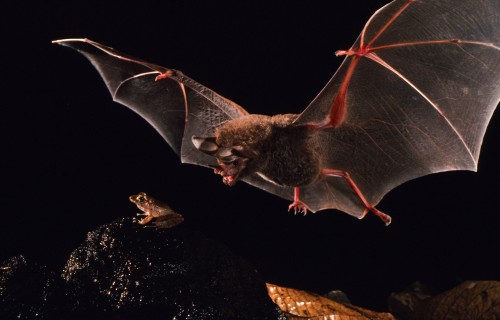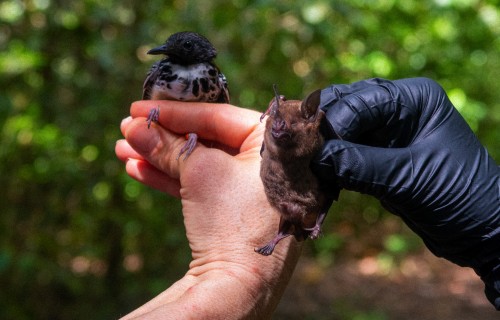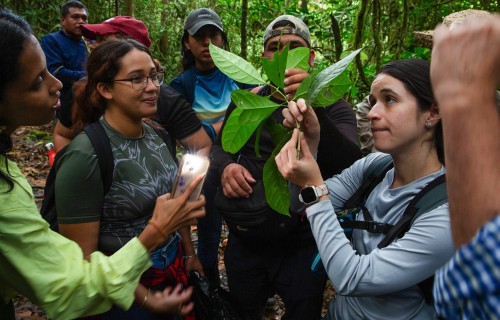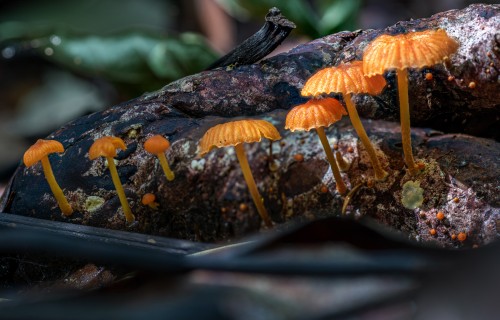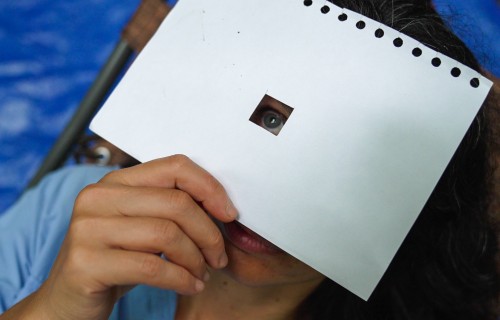Pseudoscorpions: Little guardians of crevices (public talk in Spanish)
Nearly
Identical
Researchers reveal 10% of insect
species in a tropical forest may
look identical to related species
By: Fern Alling
A new study from the Smithsonian Tropical Research Institute (STRI) estimates 10% of insect species on Barro Colorado Island may be cryptic, or visually indistinguishable from related species, highlighting potential gaps in scientists’ understanding of ecosystem dynamics.
It can be hard to tell some bugs apart. You’re unlikely to mistake a rhinoceros beetle for a monarch butterfly, but seeing the difference between two ant species is a challenge for the untrained eye. Even taxonomists who specialize in identifying generic black beetles can get it wrong. That’s because some insect species look exactly the same on the outside, even to a trained scientist.
These identical-looking insects are called cryptic species. Because cryptic species are indistinguishable from each other, it’s hard for scientists to know how many of them there are in a given ecosystem. But a recent paper published by STRI’s Arthropod Lab has an estimate. The study found that 10.6% of species on Barro Colorado Island research station (BCI) may be cryptic, highlighting the challenge of understanding biodiversity in a tropical forest.
Orchid bees (Euglossini) are one of the families of arthropods where cryptic species can appear, because species look incredibly alike. Scientists visually determined these bees in this box are all in the same species, but DNA sequencing may reveal hidden species among them. Credit: Jorge Alemán, STRI.
“If you’re lumping all species together, you’re going to make some errors,” said Yves Basset, principal investigator at the Arthropod Lab and an author of the study. “Since the species are isolated, they might have a different ecology.”
Cryptic species might look the same, but their genetics are different. Though there are multiple ways to classify a species, a generally agreed-upon definition is that organisms in the same species share 98% of their DNA. But if a pair of identical-looking butterflies share 97% or less of their genetic material, one could be a cryptic species.
To assess how many cryptic species may be present on BCI, the researchers used DNA from the Arthropod Lab’s vast collection of insect specimens gathered from the island; the lab collects tens of thousands of individual insects each year as part of its long-term monitoring to track how different species on the island are responding to climate change. The lab sent over 7,500 samples from their reference collection – typically a portion of the specimen’s leg – to the University of Guelph, which sent back genetic information the lab used to identify cryptic species.
Understanding exactly how many species are present in an ecosystem helps researchers paint a more complete picture of the relationships within that ecosystem. Cryptic species may have vastly different life cycles compared to their lookalikes, so understanding their presence gives clues into hidden dynamics scientists might be missing.
The Nymphalidae family of butterflies is one of the arthropod families where cryptic species can appear. Even though scientists spotted the differences between the butterflies shown here (each box holds one Nymphalidae species), they still look incredibly alike. Credit: Jorge Alemán, STRI.
Identifying cryptic species also creates the potential for scientists to uncover something useful for humans. “Maybe we discover bacteria species A has a cure for AIDS or COVID. Then, you want to be able to distinguish it from another species,” Basset said.
Since the entire collection has not been sequenced, the real number of cryptic species on BCI is likely higher. Daniel Souto, a co-author of the paper, said the more specimens are sequenced, the more likely it is that new cryptic species will be found. “It’s like we’re running in a treadmill,” he explained. “The longer we run, the more other species will catch up to us.”
The number of species the Arthropod Lab keeps records on is another limitation of the study. Basset estimates there are 300 to 350 insect families on BCI, yet, for capacity reasons, the lab only maintains data on species from 23 families. If the lab were to expand its monitoring protocols, more cryptic species discoveries would likely follow.
In future studies, Basset said he plans to continue drawing on the lab’s collection to examine what factors create cryptic species. In addition to gathering valuable data on how tropical insects respond to climate change, the lab’s long-term monitoring on BCI opens the door for other incredible discoveries.
“Without the monitoring, there’s no way we could’ve done a study like this,” Basset said.
Yves Basset, STRI staff scientist, holds up a katydid nymph. Credit: Fern Alling
Reference: Basset, Y., Lamarre, G.P.A., Donoso, D.A., Souto-Vilarós, D., Perez, F., Bobadilla, R. et al. 2025. The magnitude of cryptic insect diversity in one tropical rainforest. Insect Conservation and Diversity, 1–12. DOI: 10.1111/icad.12861









